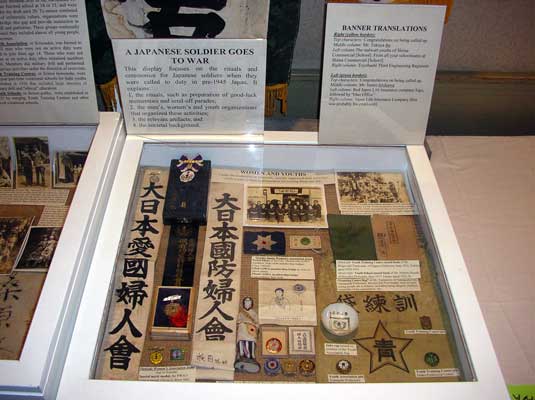My
Display Wins Best of Show at the
Military
Collectors Club of Canada 2006 Show!
The Military Collectors Club (MCC)
of

The long banners at the ends and the
three smaller ones in the centre are shussei
nobori, send-off banners that were carried in the parades held to send off
the troops. The big writing down the middle of each banner is a soldier’s name.
The flag with the rayed sun and purplish-blue bottom (lower left) served a
similar purpose but was made in rare flag format. The two
red-sun-on-a-white-background (“meatball”) flags are hinomaru yosegaki, or good luck flags decorated with slogans and
signatures of well-wishers. The bluish flag with the strange white symbol in
the middle in the lower right is the flag of the Dai nippon fujinkai, or Greater Japan Women’s Association, one of
the groups that helped organize the ceremonies. I constructed a bamboo frame to
hang the cloth artifacts and used pairs of tiny rare earth magnets to suspend
them from ribbons wrapped around the horizontal bamboo poles.
The first case has service medals
from Japan’s wars during the 1894-1945 period; badges from the Teikoku zaigo gunjinkai, or Imperial
Reservists’ Association, the key group that ran the send-off ceremonies; a hokobukuro, or service records bag; and
some of the items that would be in such a bag (soldiers and reservists had to
keep the items at the ready in these bags in case of call-up). In the middle
there are some period photos of Japanese soldiers and of a soldier’s funeral.
Along the bottom are wound and bereavement medals as well as cigarettes with
the Imperial chrysanthemum crest that were sometimes given to returning
soldiers.

The second case featured items from
a Corporal Yonejiro Ogita, a machine gunner born in 1916 in Hikone,

The third case features a
thousand-stitch belt (senninbari)
prepared to bring a soldier good luck, comfort bags (imonbukuro) used to send treats to soldiers at the front, and
original photos of soldiers at their send-off ceremonies.

The last case had items from the
women’s and youth associations who assisted in organizing the send-off
ceremonies. Notable amongst these are the sashes from women’s organizations and
the medal in the upper left, which was the highest merit award given by the Dai nippon aikoku fujinkai (Greater
Japan Patriotic Women’s Association), a very rare medal.

Here I am at the awards banquet on
Saturday evening, August 12, receiving the Best of Show award from the National
President of the MCC, Lou Grimshaw. He is a retired Canadian military officer,
hence the medals he is wearing.

Here I am in front of my display
after receiving my awards. Besides the Best of Show plaque in my left hand, I
also got one of three Gold Awards, which I am holding in my right hand. They
give out three bronze, three silver and three gold awards, as well as Best of
Show, Best in Theme and Best Canadian. The theme for 2006 was the

Here is the Best of Show plaque and
the Gold Award. The Gold Award was a lead soldier under glass. I am told the
soldier is a replica of a

This show was the first time I had
done a non-gun display and also much smaller than my usual gun displays, so I
was very gratified at the positive reception it received.
To return
to the home page, please click here: Nambu
World: Teri’s WWII Japanese Handgun Website
Last updated: August 15, 2006. All contents are copyright Teri
unless otherwise specified and may not be used elsewhere in any form without
prior permission.